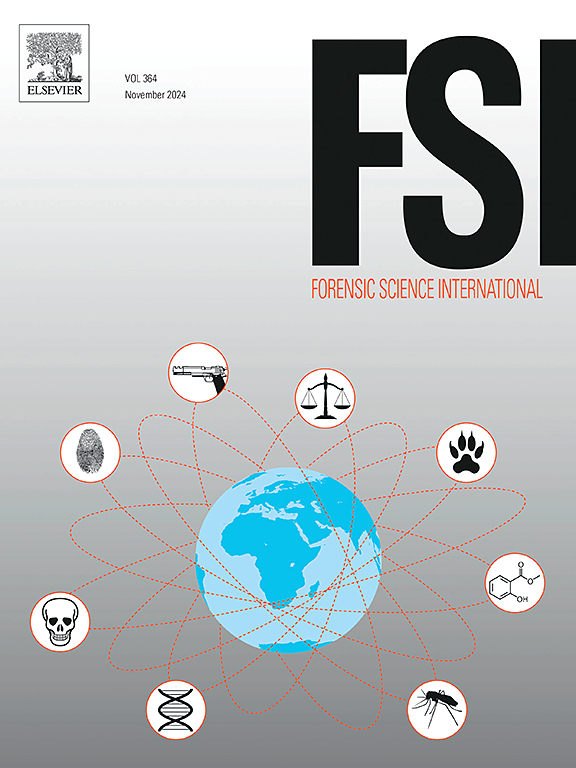Point-of-care β-hydroxybutyrate and glucose as candidate screening methods for ketoacidosis-associated death in forensic autopsy investigations
IF 2.2
3区 医学
Q1 MEDICINE, LEGAL
引用次数: 0
Abstract
Objectives
Ketone bodies, like β-hydroxybutyrate (BHB), derived from fatty acid breakdown, can cause fatal ketoacidosis if levels are excessively high. Postmortem diagnosis of ketoacidosis is challenging due to non-specificity of rapid chromogenic tests and the time required for LC-MS/MS analysis. This study investigates the feasibility of using point-of-care (POC) BHB and glucose testing to diagnose ketoacidosis-related deaths and distinguish between diabetic and other types of ketoacidosis, post-mortem.
Design and methods
This study evaluated the Nova StatStrip meter’s analytical and post-mortem performance for measuring BHB and glucose in decedent whole blood and vitreous humor. Precision, linearity, and recovery were assessed. BHB and glucose were measured in whole blood and vitreous humor from 100 autopsy cases (both ketoacidosis and non-ketoacidosis deaths). Results were compared quantitatively and qualitatively with standard laboratory methods to determine the meter's accuracy and reliability in predicting ketoacidosis-related deaths. Receiver operating characteristic (ROC) curves were constructed for each matrix/analyte combination to evaluate screening capabilities for ketoacidosis- and diabetic ketoacidosis-related deaths.
Results
Imprecision was highest in decedent vitreous humor samples for both BHB and glucose and both assays exhibited acceptable linearity. ROC curve analysis indicated comparable post-mortem performance between methods and matrices. Whole blood BHB showed the best performance for predicting all-cause ketoacidosis on the meter, despite exhibiting a higher device error messages than vitreous humor. Glucose in vitreous humor exhibited the most optimal performance (100 % sensitivity and specificity) but showed the highest rate of error messages (64 %). Thus, whole blood glucose (80 % sensitivity, 98 % specificity) would be the preferred matrix to identify potential DKA-related deaths. Agreement between meter and laboratory methods was excellent despite differing thresholds (96–100 %).
Conclusions
This study suggests that post-mortem BHB levels in whole blood and vitreous humor can be conveniently obtained using the StatStrip meter and have comparable performance to current standards, making it suitable as a screening tool for ketoacidosis-related death. Screening thresholds recommended are vitreous humor (≥ 0.9 mmol/L) or whole blood (≥ 1.6 mmol/L) BHB for ketoacidosis-related death, followed by whole blood glucose (≥ 27.3 mmol/L) for DKA-related death.
即时护理β-羟基丁酸盐和葡萄糖作为法医尸检中酮症酸中毒相关死亡的候选筛选方法
目的由脂肪酸分解产生的酮体,如β-羟基丁酸酯(BHB),如果含量过高,可引起致命的酮症酸中毒。由于快速显色试验的非特异性和LC-MS/MS分析所需的时间,死后诊断酮症酸中毒具有挑战性。本研究探讨了使用点护理(POC) BHB和葡萄糖检测诊断酮症酸中毒相关死亡的可行性,并在死后区分糖尿病和其他类型的酮症酸中毒。设计和方法本研究评估了Nova StatStrip仪在测定死者全血和玻璃体体液中BHB和葡萄糖的分析和死后性能。评估了精密度、线性度和回收率。对100例尸检病例(酮症酸中毒和非酮症酸中毒死亡)的全血和玻璃体体液中BHB和葡萄糖进行了测定。将结果与标准实验室方法进行定量和定性比较,以确定该仪器预测酮症酸中毒相关死亡的准确性和可靠性。为每种基质/分析物组合构建受试者工作特征(ROC)曲线,以评估筛查酮症酸中毒和糖尿病酮症酸中毒相关死亡的能力。结果鲎试剂测定BHB和葡萄糖的精密度在玻璃体体液样品中最高,两种方法均具有可接受的线性关系。ROC曲线分析显示,两种方法的尸检效果相当。全血BHB在预测仪表上的全因酮症酸中毒方面表现最好,尽管显示出比玻璃体幽默更高的设备错误信息。玻璃体中的葡萄糖表现出最佳的性能(100 %的敏感性和特异性),但显示出最高的错误信息率(64 %)。因此,全血糖(80% %的敏感性,98% %的特异性)将是识别潜在的dka相关死亡的首选基质。尽管阈值不同(96-100 %),但仪表和实验室方法之间的一致性非常好。结论StatStrip仪可方便地测定死后全血和玻璃体中BHB水平,其性能与现行标准相当,适合作为酮症酸中毒相关死亡的筛查工具。酮症酸中毒相关死亡的筛查阈值推荐为玻璃体(≥0.9 mmol/L)或全血(≥1.6 mmol/L) BHB,其次是dka相关死亡的全血血糖(≥27.3 mmol/L)。
本文章由计算机程序翻译,如有差异,请以英文原文为准。
求助全文
约1分钟内获得全文
求助全文
来源期刊

Forensic science international
医学-医学:法
CiteScore
5.00
自引率
9.10%
发文量
285
审稿时长
49 days
期刊介绍:
Forensic Science International is the flagship journal in the prestigious Forensic Science International family, publishing the most innovative, cutting-edge, and influential contributions across the forensic sciences. Fields include: forensic pathology and histochemistry, chemistry, biochemistry and toxicology, biology, serology, odontology, psychiatry, anthropology, digital forensics, the physical sciences, firearms, and document examination, as well as investigations of value to public health in its broadest sense, and the important marginal area where science and medicine interact with the law.
The journal publishes:
Case Reports
Commentaries
Letters to the Editor
Original Research Papers (Regular Papers)
Rapid Communications
Review Articles
Technical Notes.
 求助内容:
求助内容: 应助结果提醒方式:
应助结果提醒方式:


